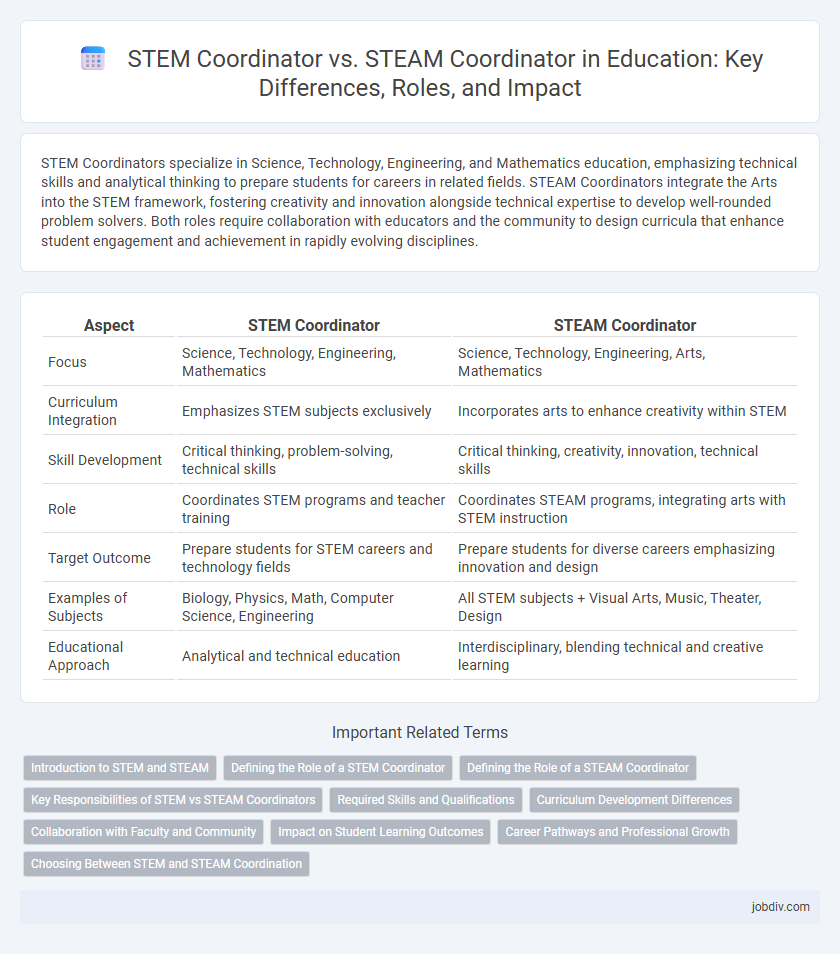STEM Coordinators specialize in Science, Technology, Engineering, and Mathematics education, emphasizing technical skills and analytical thinking to prepare students for careers in related fields. STEAM Coordinators integrate the Arts into the STEM framework, fostering creativity and innovation alongside technical expertise to develop well-rounded problem solvers. Both roles require collaboration with educators and the community to design curricula that enhance student engagement and achievement in rapidly evolving disciplines.
Table of Comparison
| Aspect | STEM Coordinator | STEAM Coordinator |
|---|---|---|
| Focus | Science, Technology, Engineering, Mathematics | Science, Technology, Engineering, Arts, Mathematics |
| Curriculum Integration | Emphasizes STEM subjects exclusively | Incorporates arts to enhance creativity within STEM |
| Skill Development | Critical thinking, problem-solving, technical skills | Critical thinking, creativity, innovation, technical skills |
| Role | Coordinates STEM programs and teacher training | Coordinates STEAM programs, integrating arts with STEM instruction |
| Target Outcome | Prepare students for STEM careers and technology fields | Prepare students for diverse careers emphasizing innovation and design |
| Examples of Subjects | Biology, Physics, Math, Computer Science, Engineering | All STEM subjects + Visual Arts, Music, Theater, Design |
| Educational Approach | Analytical and technical education | Interdisciplinary, blending technical and creative learning |
Introduction to STEM and STEAM
STEM Coordinators focus on integrating science, technology, engineering, and mathematics into curriculum development and classroom instruction to enhance students' analytical and problem-solving skills. STEAM Coordinators expand this framework by incorporating the arts, promoting creativity and innovation alongside technical proficiency. Both roles are critical for fostering interdisciplinary learning environments that prepare students for future careers in technology and creative industries.
Defining the Role of a STEM Coordinator
A STEM Coordinator oversees the integration of science, technology, engineering, and mathematics programs, ensuring curriculum alignment and fostering collaboration among teachers to enhance student achievement. They analyze data to improve instructional strategies and coordinate professional development focused on STEM education. Unlike STEAM Coordinators, STEM Coordinators emphasize technical disciplines without the explicit incorporation of arts and creativity in the curriculum.
Defining the Role of a STEAM Coordinator
A STEAM Coordinator integrates Science, Technology, Engineering, Arts, and Mathematics to foster interdisciplinary learning and creativity in educational settings. Unlike a STEM Coordinator who concentrates primarily on traditional STEM subjects, the STEAM Coordinator emphasizes the inclusion of arts to enhance critical thinking and innovation. This role involves curriculum development, teacher collaboration, and promoting project-based learning that combines artistic expression with scientific inquiry.
Key Responsibilities of STEM vs STEAM Coordinators
STEM Coordinators primarily focus on integrating science, technology, engineering, and math curricula, managing program development, and facilitating teacher training to enhance student achievement in STEM fields. STEAM Coordinators expand these responsibilities by incorporating the arts into the curriculum, promoting interdisciplinary project-based learning, and fostering creativity alongside technical skills. Both roles require collaboration with educators and administrators to align educational standards and support resource allocation for effective program implementation.
Required Skills and Qualifications
STEM Coordinators require strong expertise in science, technology, engineering, and mathematics, coupled with skills in curriculum development, data analysis, and project management to effectively integrate these disciplines into educational programs. STEAM Coordinators possess similar qualifications but emphasize creativity and the integration of the arts, necessitating abilities in interdisciplinary collaboration, design thinking, and innovative instructional strategies. Both roles demand excellent communication, leadership capabilities, and proficiency in educational technology to foster student engagement and support teacher development.
Curriculum Development Differences
STEM Coordinators concentrate on integrating science, technology, engineering, and mathematics into a cohesive curriculum that emphasizes analytical skills and problem-solving through technical concepts. STEAM Coordinators expand this framework by incorporating the arts, fostering creativity, critical thinking, and innovation alongside technical knowledge to develop interdisciplinary learning experiences. Curriculum development under STEM focuses on quantitative and empirical methods, while STEAM promotes a balance of creative processes and scientific inquiry to address diverse learning styles.
Collaboration with Faculty and Community
STEM Coordinators emphasize collaboration with faculty by integrating science, technology, engineering, and mathematics curricula to enhance student learning outcomes, focusing on data-driven instructional strategies. STEAM Coordinators expand this collaboration by incorporating arts into interdisciplinary projects, fostering creativity alongside critical thinking among educators and community partners. Both roles prioritize building partnerships with local businesses and organizations to provide real-world experiences and resources that enrich STEM/STEAM education.
Impact on Student Learning Outcomes
STEM Coordinators emphasize science, technology, engineering, and mathematics to enhance critical thinking and problem-solving skills, directly improving student performance in standardized assessments. STEAM Coordinators integrate the arts into STEM subjects, fostering creativity and innovation, which leads to higher student engagement and holistic learning outcomes. Research shows students in STEAM programs demonstrate improved collaboration and adaptability, essential for future career success.
Career Pathways and Professional Growth
STEM Coordinators specialize in Science, Technology, Engineering, and Mathematics, focusing on developing programs that enhance technical proficiency and analytical skills, which align with careers in engineering, computer science, and data analysis. STEAM Coordinators expand this framework by integrating the Arts, promoting creativity and innovation alongside technical knowledge, preparing students for diverse career pathways including design, digital media, and creative technologies. Both roles offer professional growth through leadership in curriculum development and cross-disciplinary collaboration, but STEAM Coordinators often navigate a broader scope of educational strategies to foster holistic student development.
Choosing Between STEM and STEAM Coordination
Choosing between STEM and STEAM coordination depends on the emphasis of the curriculum; STEM focuses on science, technology, engineering, and mathematics, while STEAM integrates the arts to foster creativity alongside technical skills. Educators should evaluate their school's goals, student needs, and community values to determine whether a purely STEM approach or an arts-infused STEAM program better supports holistic learning and innovation. Effective coordinators balance technical rigor with creative exploration, promoting interdisciplinary projects that prepare students for diverse career paths in a rapidly evolving job market.
STEM Coordinator vs STEAM Coordinator Infographic

 jobdiv.com
jobdiv.com